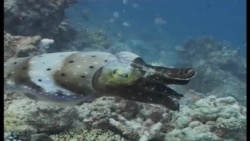We know more about the surface of the planet Mars than we know about what is at the bottom of Earth’s oceans.
Until recently, scientists had mapped only about 20 percent of the sea floor. But our knowledge of the deep seas is changing because of information from satellites. Scientists have produced a new map that provides a detailed picture of the oceans. The map is expected to help oceanographers, industry and governments.
The new map is two times as detailed as the map made 20 years ago. David Sandwell is a geophysics professor at the Scripps Institution of Oceanography at the University of California. He and other scientists worked on the mapping project. He says they turned to space to look deeper into the ocean. He spoke to VOA on SKYPE.
“The way we’re doing that is to use a satellite altimeter, a radar to map the topography of the ocean surface. Now that seems sort of strange that you'd map the topography of the ocean surface when you really want to get at the sea floor. But, the ocean surface topography has these bumps and dips due to gravitational effects that mimic what’s on the sea floor.”
The scientists collected and studied information from two satellites. Some of the data came from the European Space Agency's Cryo-2 satellite. It was placed in Earth’s orbit to watch sea ice. The other satellite is the American space agency’s Jason-1. It is studying the surface of the oceans. Scientists combined the satellite data with images gathered by sonar equipment on ships. Sonar works by sending sound waves through the water. When the sound waves hit an object, its presence is confirmed.
“That enables us to look at smaller-scale features and also features that are buried by sediments in the ocean basins.”
The new map shows the sea floor as it has never been seen before. It shows thousands of underwater mountains and places where continents pulled apart. It shows where earthquakes were active many years ago. They all are buried deep underneath the ocean floor.
In one place, three mountain ridges join at the same area. Huge tectonic plates can be seen clearly there.
“It’s called the Indian Ocean Triple Junction. It’s one of my favorite spots in the ocean because it really displays the theoretical aspects of plate tectonics perfectly. You have three plates -- the African plate, and the Indo-Australian plate and the Antarctic plate -- all connected at this one point in the center of the Indian Ocean.”
David Sandwell says the map is a powerful tool for fisheries, those interested in protecting the environment and for oil exploration.
“(The) petroleum exploration industry is interested in how to reconnect the continents, bring them back together tectonically so you can map the basins (on) one continental margin -- say, Africa -- and use that to establish where the similar basin would be on the other continental margin in South America.”
If scientists know that information, they may be able to find oil fields.
The new data also will help scientists improve their estimates of ocean depths. This information can help ships travel safely and improve military operations and scientific projects worldwide.
“This new gravity map really provides a reconnaissance tool for planning shipboard surveys. You don’t have to go out with your ship and start looking for something new -- we can target that with the gravity and then go out with the ship and do the high resolution survey to really understand these features.”
Mr. Sandwell thinks scientists will make many more discoveries as they examine the new map and the information it provides.
The work is described in the journal Science.
I’m Christopher Cruise.
This story was reported by VOA Science Correspondent Rosanne Skirble. Christopher Cruise wrote the story for Learning English. He also produced the program. The editor was George Grow.
_____________________________________________________________
Words in This Story
surface – n. the upper layer of an area of land or water
map – n. a picture or chart that shows the rivers, mountains and streets in a particular area
detailed – adj. including many details; including a lot of information
device – n. an object, machine, or piece of equipment that has been made for some special purpose
underneath – prep. below or beneath (something)
Now it’s your turn to use these Words in This Story. In the comments section, write a sentence using one of these words and we will provide feedback on your use of vocabulary and grammar.








